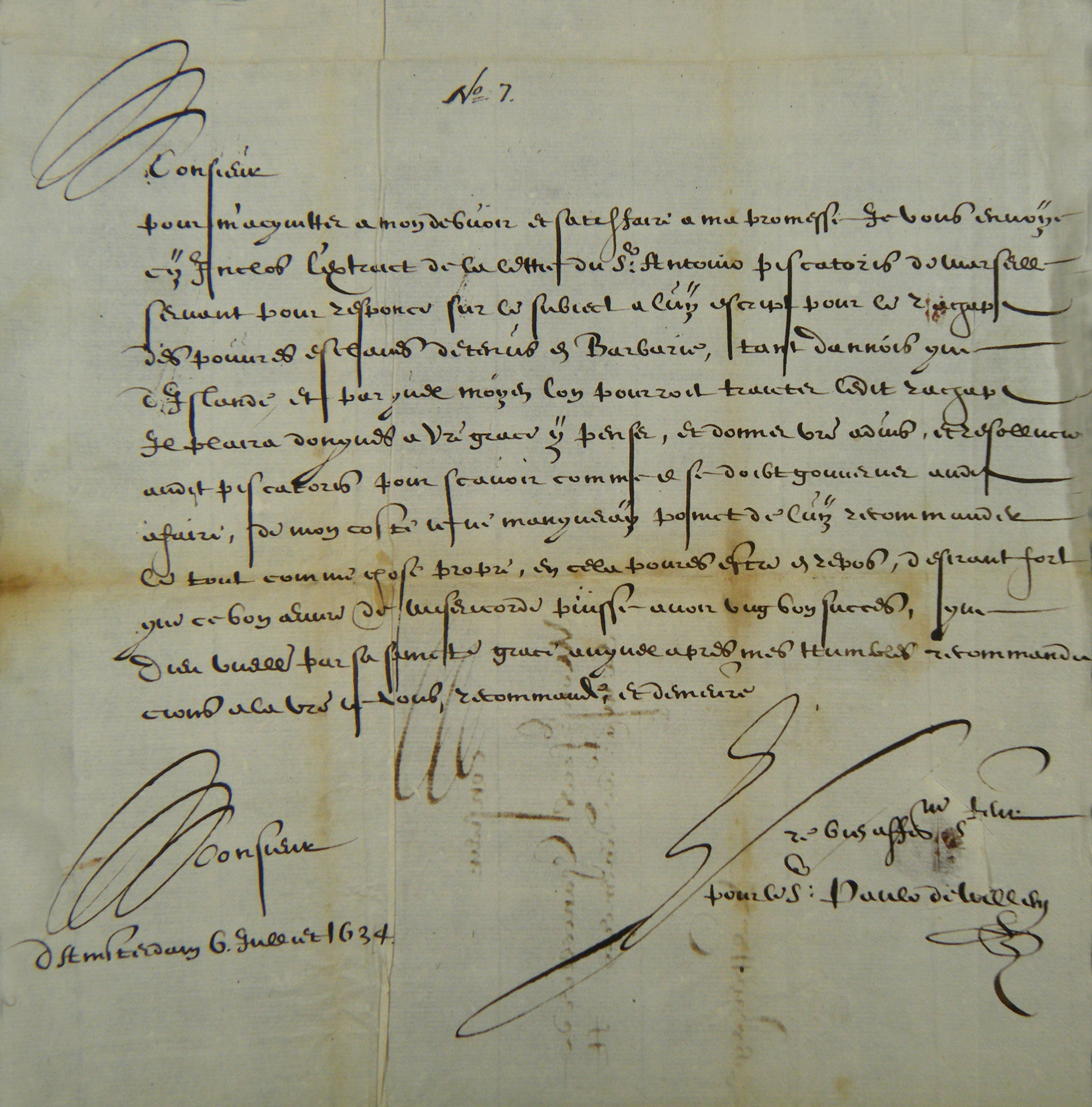In the summer of 1627, Barbary corsairs raided Iceland and captured close to 500 people whom they carted off to Salé and Algiers to sell into slavery. The group of Icelanders (nearly 400) taken to Algiers were sold there in the Batistan, the slave market. But they were also offered up for ransom.
In the seventeenth century, Iceland was a Danish possession, so the ransom needed to be organized under the auspices of the Danish King.
It took almost a decade—the winter of 1635-36—before money could be raised and a proper ransoming expedition sent to Algiers.
The responsibility for organizing the ransoming process fell to a Dutchmen named Paul de Willem. He contacted a French merchant, named Antoine Piscatoris, who lived in Marseilles and had experience in such matters. Piscatoris wrote de Willem back with suggestions for how to proceed.
We know this, because we have the letter, dated July 6, 1634, that de Willem sent to the Danish government official in Copenhagen who was overseeing the ransoming process.
The image above is of that letter.
The letter was written in French. Below, is a transcription of the French text (with all its eccentric seventeenth century spelling), followed by a rendering into English:
_____________________________________
Monsieur,
Pour m’acquitter à mon devoir et satisfaire à ma promesse Je vous envoie cij Inclos l’extract de la lettre du Ser Antonio Piscatoris de Marseille servant pour réponse sur le subiet a lui écrit pour le rachat des pauvres esclaves détenus en Barbarie, tant danois que d’Islande et par quel moyen lui pourroit traicter ledit rachat. Il plaira donc à Votre grâce de penser, et donner votre avis et résolution audit Piscatoris pour savoir comme il se doit gouverner audi affaire, de mon côté je manquera point de lui recommander le tout comme chose propre, en celui poures est en repos, désirant fort que ce bon acte de miséricorde puisse avoir bon succès, que Dieu veule par sa sante grâce auquel après mes humbles recommandacions a la vôtre a vous recommandez, et demeure
Monsieur Votre … affect. serviteur
d’Amsterdam 6 Juillet 1634 pour le S. Paulo de Willem
_____________________________________
Sir,
To fulfill my duty and to satisfy my promise I send you the enclosed extract of a letter from Sr. Antonio Piscatoris of Marseilles, serving as a response on the subject about which I had written to him, the redemption of the poor slaves detained in Barbary, both Danish and Icelandic, and explaining by what means he could further the said redemption. May it please your grace to think and to give your opinion and decision to the said Piscatoris, to let him know how the said affair should be governed. For my side, I cannot fail to recommend him and everything he suggests as proper, and thus to settle everything, strongly desiring as I do that this good act of mercy should meet with great success, and that God so wishes it by his divine grace. Such are my humble recommendations. The final endorsement is yours. I remain…
Sir your affectionate servant
Amsterdam 6 July 1634 for S. Paulo de Willem
_____________________________________
It seems that the Danish official took de Willem’s (and Piscatoris’) advice, and the ransom expedition eventually sent to Algiers was successful—though not as successful as they might have hoped. Of the original 400 or so, de Willem & co. succeeded in ransoming only 35 Icelanders (28 women and 7 men).
Why so few?
Some had converted to Islam (especially those who had been young when captured) and had managed to make new lives for themselves in Algiers that they were unwilling to leave (after converting, they wouldn’t have been ransomable in any case). Many had died, though.
In 1629, two years after their original capture, the Icelanders enslaved in Algiers sent a letter of supplication to the Danish King. It begins as follows:
_____________________________________
Greetings to our most gracious sovereign,
We poor slaves from Iceland in this vale of tears, this vale of the heathens, with its afflictions and dangers to our souls, we who are loved by our parents and siblings, we who live in misery, wretchedly persecuted, we have already petitioned several times to your princely grace, our beloved king, high and revered father, kingly majesty, our most gracious lord, in the humblest manner. Now only the deepest danger has brought us to petition you again with the most due reverence. Even though we have been hitherto without consolation, yet we hope that your princely grace will consider the wretched lives of the 120, young and old, that remain of your 380 subjects, and that you will not abandon us but will redeem us and thus make us feel your love.
_____________________________________
So two years after their capture, less than a third of the Icelanders were left. Not all had died necessarily, but it is likely that many of them had.
Reverend Ólafur Egilsson, one of the Icelandic captives, wrote a memoir of his experiences. In it, he says this of the Icelanders’ early days in Algiers:
“I was told that that many Icelandic people were lying sick and dying all around the town, which did not make us happy. I was also told that in the Christian cemetery there were already thirty-one buried. The Icelanders could not endure the terrible heat of that place.”
Life for the enslaved Icelanders did not get any easier. Their daily lives were hard, and their hopes of ransom and freedom went unfulfilled for almost ten years. Little wonder there were so few of them left when the Danish ransoming expedition finally arrived.
Tough times.
 The Travels of Reverend Ólafur Egilsson
The Travels of Reverend Ólafur Egilsson
The story of the Barbary corsair raid on Iceland in 1627
Amazon listing